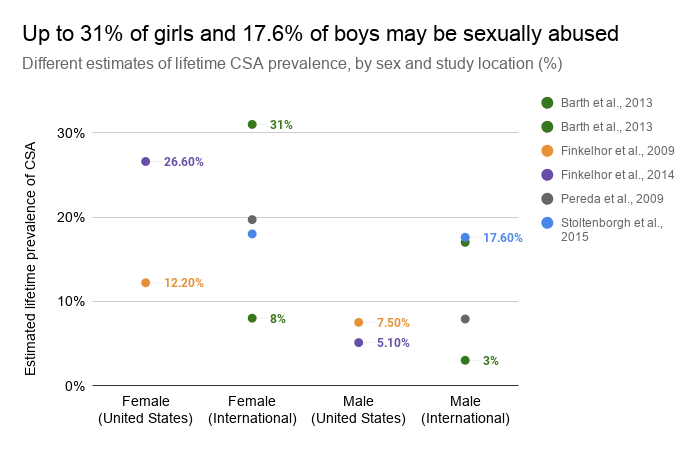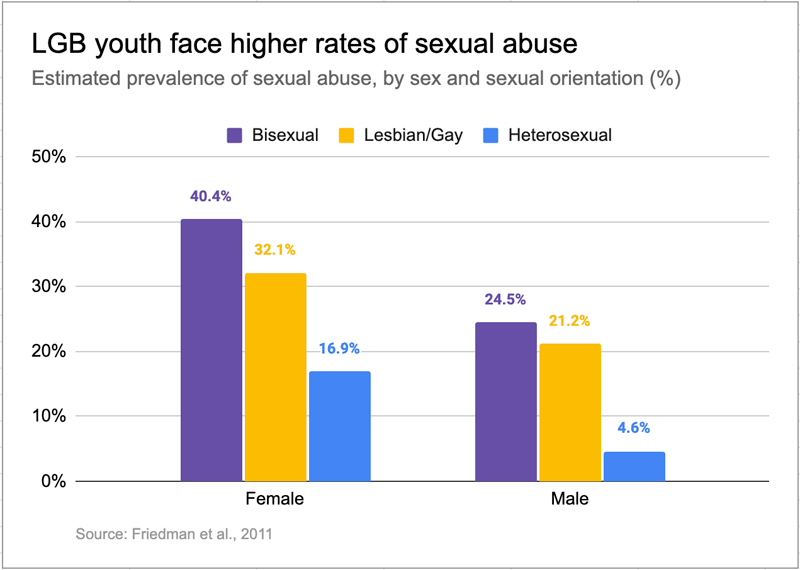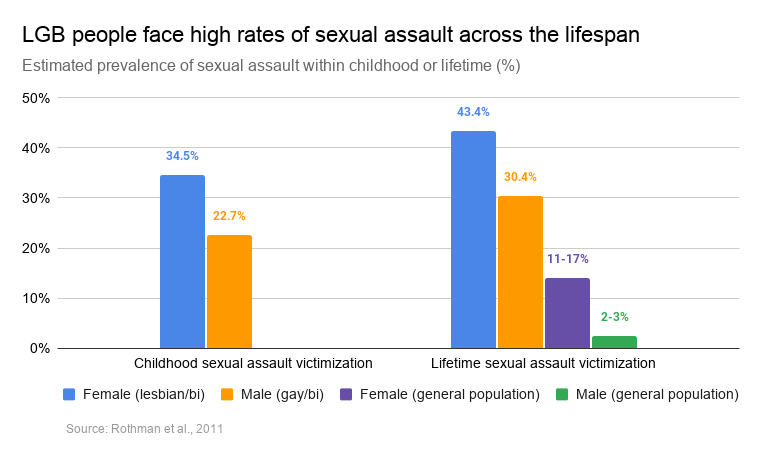Summary
Child sexual abuse (CSA) has frequently been found to a widespread, global issue. Estimates of prevalence of CSA, or how often CSA occurs, range from 8-31% of girls and 3-17.6% of boys internationally, and 12.2-26.6% of girls and 5.1-7.5% of boys in the United States. Prevalence estimates vary in part because of differences in studies’ methodologies, including the use of different definitions of abuse and acts that constitute CSA, as well as what participants were included in the study, when the study was conducted, the number and type of questions asked, and how data was collected. Research suggests that diverse groups of youth including lesbian, gay, and bisexual youth, youth with disabilities, and youth of color may experience higher CSA prevalence rates compared to heterosexual, non-disabled, and white youth, respectively, and more research is needed to understand differences in prevalence and risk acoss groups.
Prevalence of Child Sexual Abuse
Prevalence measures how often a characteristic occurs in the general population. The prevalence of CSA is difficult to measure, due to the fact that many youth never disclose their abuse or delay disclosure into adulthood. In research studies, varying methodologies have also produced different prevalence rates of CSA (see Variations in Prevalence Estimates). Despite complications in measuring the magnitude of CSA, studies consistently demonstrate that CSA is a widespread issue impacting youth in every community.
CSA is a widespread issue impacting youth in every community.
The following chart summarizes data from multiple research studies on the overall prevalence of CSA at national and international levels. The international studies capture CSA prevalence across many countries and continents, whereas the national data is based on studies conducted in the United States.
Estimates of CSA prevalence in the United States demonstrate that at least one in eight girls (12.2%) and up to one in four girls (26.6%), and at least one in twenty boys (5.1%) and up to one in fourteen boys (7.5%), experience CSA at some point.12 Internationally, prevalence estimates range more widely, both higher and lower, from 8-31% among girls and 3-17.6% among boys.345 Taken together, these studies demonstrate that CSA is widespread worldwide and may affect up to as many as one in three girls (31%) and up to more than one in six boys (17.6%).

Prevalence of Child Sexual Abuse Among Diverse Youth
Lesbian, Gay, Bisexual, and Transgender Youth
Studies have consistently found that lesbian, gay, and bisexual (LGB) youth experience disproportionately higher rates of CSA prevalence compared to their heterosexual peers. For example, one study found that gay and lesbian youth were 2.5 times more likely, and bisexual youth 2.8 times more likely, to be sexually abused than were heterosexual youth6
The figure below presents the results of a meta-analysis which, reporting an even greater disparity, found that LGB youth were, on average, 3.8 times more likely to experience CSA than their heterosexual peers. More specifically, the study found CSA prevalence rates of 40.4% for bisexual females, 32.1% for lesbian females, and 16.9% for heterosexual females, as well as 24.5% for bisexual males, 21.2% for gay males, and 4.64% for heterosexual males.7

Another study on rates of sexual assault prevalence in childhood and adulthood similarly reported that 34.5% of lesbian/bi females and 22.7% of gay/bi males experienced sexual assault as a child (see figure below). The study additionally found disproportionately higher sexual assault prevalence rates among LGB adults versus the general population, which suggests there is an increased risk of sexual violence to lesbian, gay, and bisexual people across the lifespan.8

While a considerable amount of research has been done regarding gay, lesbian, and bisexual youth, there has yet to be significant research conducted on CSA prevalence among transgender or gender diverse youth.
Disabled Youth
Some research has suggested that children with disabilities are at increased risk for CSA.910 One study found that disabled children were 3.4 times more likely to be abused than non-disabled peers.11 A review of research dating as far back as the 1960s reported that prevalence of CSA in disabled children ranged from 4% to 83%.12 A more recent review could only identify four studies that met their criteria for inclusion and found that evidence for a connection between disability and increased CSA is weak.13 More research is needed to provide a more accurate estimate of prevalence of CSA among disabled youth.
Youth of Color
Race and ethnicity have been grossly understudied and underreported in regard to CSA prevalence. Results of the National Incidence Survey (NIS) indicate that Black children have nearly twice the risk of sexual abuse as white children (2.6 per 1,000 children versus 1.4 per 1,000 children, respectively). Hispanic children have an incidence rate of 1.8 per 1,000 children: a slightly greater risk for sexual abuse than non-Hispanic white children.14 These data exclude analysis of other racial groups (including American Indian or Alaska Native, Asian, Native Hawaiian or other Pacific Islander, and mixed race) because they did not have large enough samples to support independent estimates.
A review of the literature identified a variety of methodological problems in research on race and ethnicity and CSA, including:
- Terminology and classifications of racial/ethnic groups vary across studies and may obscure factors critical to understanding CSA;
- Retrospective self-reports of abuse;
- Small sample sizes and unrepresentative samples;
- Underreporting by race/ethnicity (which is suggested to occur in Asian American populations)15
Ultimately, findings were inconsistent regarding whether prevalence rates for CSA differ by race/ethnicity, and to what extent variations might be explained by socioeconomic status.15
Research screening for diverse youth identities, including race/ethnicity, disability, sexual orientation, and socioeconomic status is needed to better understand the prevalence rates and differential risk for CSA among these subgroups of youth.
Variations in Prevalence Estimates
Variations in CSA estimates are attributed to a number of factors, including differing definitions of CSA and other methodological differences across research studies.
Different definitions and other methodological factors result in variations in CSA prevalence estimates.
Three major concepts related to CSA that vary across definitions are:
- The definition of abuse (e.g. age of the child involved, relationship and potential age difference between the child and abuser);
- Acts that constitute CSA (e.g. inclusion or exclusion of non-contact acts such as voyeurism, or questions of which non-contact acts qualify as CSA)16
Other methodological factors that impact prevalence estimates include:
- Sampling technique (e.g., random sampling, non-probability sampling within a specific population, or requesting volunteers from a population)17
- The time period (dates) of the study and the awareness of CSA at that time1718
- Number and type of questions asked to identify CSA1718
- Method of data collection (paper and pencil survey, computer survey, self-administered questionnaire, telephone interview, or face-to-face interview)17,19
While these variables may render comparison of prevalence rates questionable, there is no agreement in the literature about whether prevalence estimates are over- or underestimated and by how much.20 Having accurate estimations of CSA prevalence — including prevalence data on subgroups of youth — is important to support efforts that address the problem, such as policy responses, prevention efforts, and support of survivors.
CSA prevalence estimates impact policy responses, prevention efforts, and support of survivors.
Juvenile Sexual Assault Statistics
According to data from the National Incident-Based Reporting System, a significant amount of all sexual assault is perpetrated against youth age 17 and younger.21 Specifically, of all sexual assault cases reported to law enforcement across the life span, victims 17 years old and younger represent:
- 67% of sexual assault reports
- 46% of forcible rape reports
- 79% of forcible sodomy reports
- 75% of reports of sexual assault with an object
- 84% of forcible fondling reports21
Of these, the most common sexual assault charge reported to law enforcement was forcible fondling (45%), followed by forcible rape (42%).21 Reports of forcible sodomy (8%) and sexual assault with an object (4%) were far less common.21
- 1. Finkelhor, D., Turner, H., Ormrod, R., & Hamby, S. L. (2009). Violence, abuse, and crime exposure in a national sample of children and youth. Pediatrics, 124(5), 1411-1423.
- 2. Finkelhor, D., Shattuck, A., Turner, H. A., & Hamby, S. L. (2014). The lifetime prevalence of child sexual abuse and sexual assault assessed in late adolescence. Journal of Adolescent Health, 55(3), 329-333.
- 3. Stoltenborgh, M., Bakermans-Kranenburg, M. J., Alink, L. R., & Ijendoorn, M. H. (2015). The prevalence of child maltreatment across the globe: A review of a series of Meta-analyses. Child Abuse Review 24(1), 37-50.
- 4. Barth, J., Bermetz, L., Heim, E., Trelle, S., & Tonia, T. (2013) The current prevalence of child sexual abuse worldwide: a systematic review and meta-analysis. International Journal of Public Health, 58(3), 469-483.
- 5. Pereda, N., Guilera, G., Forns, M., & Gómez-Benito, J. (2009). The prevalence of child sexual abuse in community and student samples: A meta-analysis. Clinical Psychology Review, 29(4), 328-338.
- 6. Andersen, J. P., & Blosnich, J. (2013). Disparities in adverse childhood experiences among sexual minority and heterosexual adults: Results from a multi-state probability-based sample. PloS One, 8(1), e54691.
- 7. Friedman, M. S., Marshal, M. P., Guadamuz, T. E., Wei, C., Wong, C. F., Saewyc, E. M., & Stall, R. (2011). A meta-analysis of disparities in childhood sexual abuse, parental physical abuse, and peer victimization among sexual minority and sexual nonminority individuals. American Journal of Public Health, 101(8), 1481-1494.
- 8. Rothman, E. F., Exner, D., & Baughman, A. L. (2011). The prevalence of sexual assault against people who identify as gay, lesbian, or bisexual in the United States: A systematic review. Trauma, Violence, & Abuse, 12(2), 55-66.
- 9. Little, L. (2004). Victimization of children with disabilities. In K. A. Kendall-Tackett (Ed.), Application and practice in health psychology. Health consequences of abuse in the family: A clinical guide for evidence-based practice (pp. 95-108). Washington, DC, US: American Psychological Association.
- 10. Jones, L., Bellis, M. A., Wood, S., Hughes, K., McCoy, E., Eckley, L., ... & Officer, A. (2012). Prevalence and risk of violence against children with disabilities: a systematic review and meta-analysis of observational studies. The Lancet, 380(9845), 899-907.
- 11. Sullivan, P. M., & Knutson, J. F. (2000). Maltreatment and disabilities: A population based epidemiological study. Child Abuse & Neglect, 24(10), 1257-1273.
- 12. Westcott, H. L., & Jones, D. P. (1999). Annotation: The abuse of disabled children. The Journal of Child Psychology and Psychiatry and Allied Disciplines, 40(4), 497-506.
- 13. Govindshenoy, M., & Spencer, N. (2007). Abuse of the disabled child: A systematic review of population-based studies. Child: Care, Health and Development, 33(5), 552-558.
- 14. Sedlak, A.J., Mettenburg, J., Basena, M., Petta, I., McPherson, K., Greene, A., and Li, S. (2010). Fourth National Incidence Study of Child Abuse and Neglect (NIS–4): Report to Congress. Washington, DC: U.S. Department of Health and Human Services, Administration for Children and Families.
- 15. a. b. Kenny, M. C., & McEachern, A. G. (2000). Racial, ethnic, and cultural factors of childhood sexual abuse: A selected review of the literature. Clinical psychology review, 20(7), 905-922.
- 16. Mathews, B., & Collin-Vézina, D. (2019). Child sexual abuse: Toward a conceptual model and definition. Trauma, Violence, & Abuse, 20(2), 131-148.
- 17. a. b. c. d. Goldman, D. G. & Padayachi, U. K. (2000). Some methodological problems in estimating incidence and prevalence in child sexual abuse research. The Journal of Sex Research 37(4), 305-314.
- 18. a. b. Bolen, R. M., & Scannapieco, M. (1999). Prevalence of child sexual abuse: A corrective metanalysis. Social Service Review, 73(3), 281-313.
- 19. Peters, S. D., Wyatt, G. E., & Finkelhor, D. (1986). Prevalence. In D. Finkelhor & S. Araji (Ed.) A Source Book on Child Sexual Abuse. (pp. 15-89). Thousand Oaks, CA: Sage.
- 20. Prevoo, M. J. L., Stoltenborgh, M., Alink, L. R. A., Bakermans-Kranenburg, M. J., Ijzendoorn, M. H. (2017). Methodological moderators in prevalence studies on child maltreatment: Review of a series of meta-analyses. Child Abuse Review, 26, 141-157.
- 21. a. b. c. d. Bureau of Justice Statistics. (2000). Sexual assault of young people as reported to law enforcement: Victim, incident, and offender characteristics. U.S. Department of Justice: Snyder, H.N. Retrieved from: https://www.bjs.gov/content/pub/pdf/saycrle.pdf